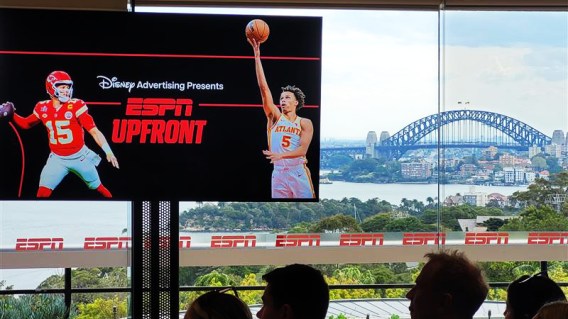
ESPN has quietly become a major Australian TV network

Upfront with a view: ESPN's event was held at Taronga Park Zoo in Sydney
ESPN wants advertisers to know that it’s the biggest game in town. Since its two linear stations and an assortment of its rich content library became available on Disney+ in March, ESPN claims it has leapfrogged Foxtel’s Kayo and Stan Sports to become Australia’s largest sports streamer.
“The integration meant that ESPN became the most widely distributed sports network in the country,” said Kylie Watson-Wheeler, the senior vice president and managing director, at a sunny ESPN upfront, held at Sydney’s Taronga Park Zoo on Tuesday afternoon.
“We’re now reaching up to 8 million homes. And it represented a real shift. It’s expanded our reach, elevated our brand presence and most importantly, opened the door for millions of Australians to connect with ESPN content – and with your brands. Our strategy and our mission has always been super, super clear. Serve sports fans anytime, anywhere.”
It was a strong sales pitch.
ESPN and ESPN2 are available through Disney+, Foxtel, Kayo Sports, Fetch TV and Sky NZ, meaning that an advertisement on ESPN reaches audiences on all those platforms. In-game integration into US sports such as the NBA, NFL, and UFC, means that Aussie sports fans could experience the jarring disconnect of seeing an AAMI logo (for example) splashed up during an NFL touchdown celebration — but it’s good news for advertisers.
As Elliot Morton from Disney’s advertising team explained: “Placing your brand in Super Bowl halftime, which is arguably the most iconic pop culture moment of sport — you’re not just reaching sports fans, but you’re reaching anyone within reach of screen.”
ESPN airs 14,000 live events a year, with a library of more than 10,000 hours of on-demand sports programming.
Sports Center regular Skubie Mageza and Geelong-born ESPN courtside commentator Kane Pitman jetted in from ESPN’s headquarters in Bristol, Connecticut, in order to sell the ESPN dream. The pair each charted their journeys from sports-mad kids born outside of the US, to ESPN commentators. (Fun fact: a few years ago, Pitman was working the graveyard shift at an oil refinery in Geelong.)
Everything the pair said was an aside to the main event — albeit very amusing, and with the easy chemistry you’d expect from professional broadcasters — but it did helped paint the brand as an aspirational icon, on par with its parent company. As Mageza said, when they arrive as a sporting event with the ESPN-red microphones, people in the stadium react: the very presence of ESPN makes it a major sporting event.
Sally O’Donoghue, Australian general manager of Disney+, hopped on stage to claim that “Disney+ is delivering a new and incremental audience for live sport. This is not the same audience that are engaging with ESPN on other platforms.”
ESPN’s recent NBA Finals coverage was up 30% on last year, thanks largely to the expanded access.
“We are unlocking new fans and they are deeply engaged, watching multiple leagues, and bridging the seasons. A high volume of sport every single day means our audiences remain consistent.”
O’Donoghue explained how its sporting content and the rest of the Disney catalogue isn’t as siloed as one might think. Disney’s internal data shows a quarter of Australians who watched the recent NBA Finals series through ESPN on Disney+, also streamed The Secret Lives of Mormon Wives. One sports fan has also streamed the entire 36 season of The Simpsons six times, and is currently in the midst of a seventh run through.
“That’s around two and a half months of straight back to back viewing, 24 hours a day,” O’Donoghue noted, before speculating the person might be present at the upfront. “We love those kinds of subscribers.”
George Henshaw from Disney’s advertising team explained that the addition of ESPN “means for the first time in Australia, advertisers will be able to reach a new, incremental audience on Disney+, with scale, high engagement, and with precise targeting.”
Every ad break will be delivered digitally, through Disney Ad Service, a proprietary advertising technology that has been built and used in the US for years.
“The Disney Ad Service has been built for streaming live sport, but most importantly, it’s been built for advertisers.”
Magnite is the programmatic partner on Disney+, in Australia and in New Zealand, and allows for dynamic ad buying.
“With Magnite, we’ve built a custom integration into the Disney Ad Server, an integration built to optimise the surge in bid requests we see in live sport, to ensure programmatic buyers never miss out on a key sporting moment,” Henshaw said.
“To support this, we’re running guaranteed and biddable deal types. And with biddable, the programmatic buyers will be able to run a unified deal across ESPN on Kayo and on Disney+, to maximise reach and scale, whilst maintaining full control over a universal 3D display frequency cap.”
From 2026, ESPN will be rolling out “new, innovative and interactive ad formats built for Disney+, and built for live sport.”
There will be ads when viewers pause live sports — similar to a format announced at the Foxtel upfront — shoppable formats, and “user-choice” advertising.
“These will all be designed to drive higher engagement and higher ROI for brands. For consumers, this will deliver a more relevant and personalized experience that doesn’t take them away from the live action.”
Early 2026 will see the introduction of Disney’s clean room solution — for collaboration between Disney and a brand, or Disney and an agency group — allowing secure planning and measurement across a combined audience set.
“The new year will also see Disney’s Bridge ID, a programmatic identity solution that integrates directly into sell side-platforms, such as Google’s Pay The Trade Desk to allow for more granular targeting.
Henshaw also used the occasion to launch Disney Select, an advanced audience targeting tool that will allow advertisers to tap into demographic and contextual segmentation, “meaning they’ll be able to overlay declared age and declared gender on our platform with the most optimal ad match rates.”
The offering will be expanding to include streaming behaviours and streaming preferences, allowing for example, brands to target NBA fans who also love Star Wars content.
“Or any ESPN fan who also has a family with two young kids who just want to watch Moana on repeat every single day.”







Hmmm … reaching 8m of the current estimated 11.3m homes (also remember that 1m homes were not occupied when the 2021 Census was done) sounds very generous.
A more useful number would be … what is the average number of homes used each day, and also what the average time was.